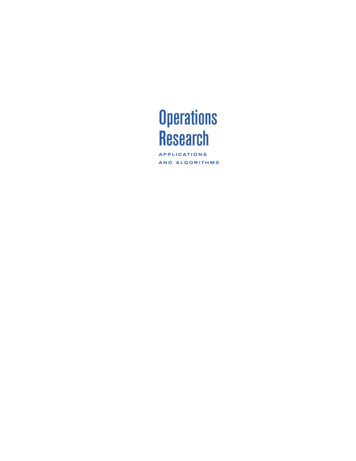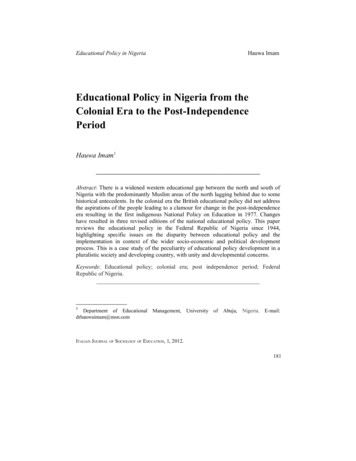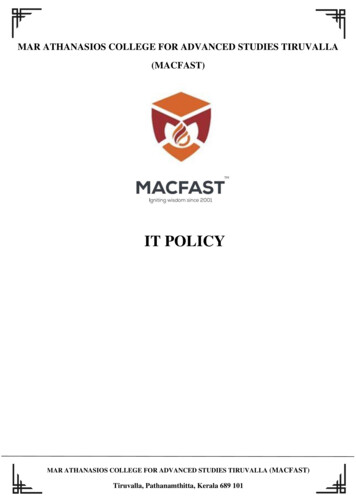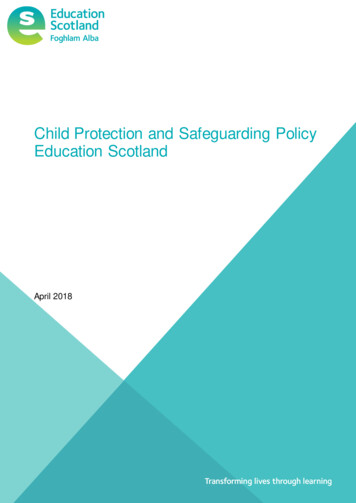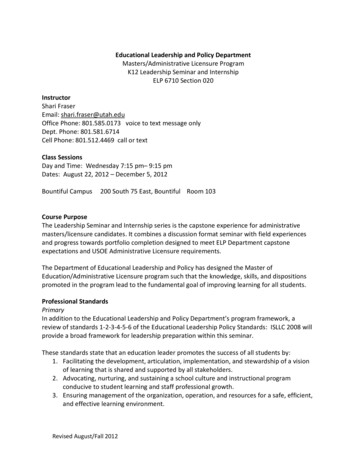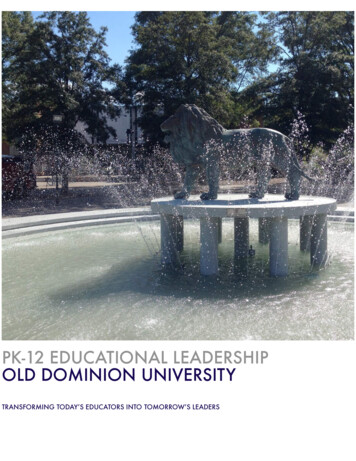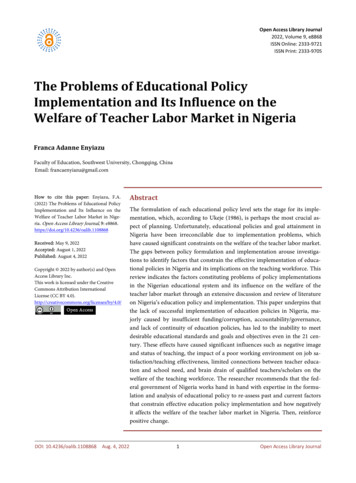
Transcription
Open Access Library Journal2022, Volume 9, e8868ISSN Online: 2333-9721ISSN Print: 2333-9705The Problems of Educational PolicyImplementation and Its Influence on theWelfare of Teacher Labor Market in NigeriaFranca Adanne EnyiazuFaculty of Education, Southwest University, Chongqing, ChinaHow to cite this paper: Enyiazu, F.A.(2022) The Problems of Educational PolicyImplementation and Its Influence on theWelfare of Teacher Labor Market in Nigeria. Open Access Library Journal, 9: d: May 9, 2022Accepted: August 1, 2022Published: August 4, 2022Copyright 2022 by author(s) and OpenAccess Library Inc.This work is licensed under the CreativeCommons Attribution InternationalLicense (CC BY en AccessDOI: 10.4236/oalib.1108868Aug. 4, 2022AbstractThe formulation of each educational policy level sets the stage for its implementation, which, according to Ukeje (1986), is perhaps the most crucial aspect of planning. Unfortunately, educational policies and goal attainment inNigeria have been irreconcilable due to implementation problems, whichhave caused significant constraints on the welfare of the teacher labor market.The gaps between policy formulation and implementation arouse investigations to identify factors that constrain the effective implementation of educational policies in Nigeria and its implications on the teaching workforce. Thisreview indicates the factors constituting problems of policy implementationsin the Nigerian educational system and its influence on the welfare of theteacher labor market through an extensive discussion and review of literatureon Nigeria’s education policy and implementation. This paper underpins thatthe lack of successful implementation of education policies in Nigeria, majorly caused by insufficient funding/corruption, accountability/governance,and lack of continuity of education policies, has led to the inability to meetdesirable educational standards and goals and objectives even in the 21 century. These effects have caused significant influences such as negative imageand status of teaching, the impact of a poor working environment on job satisfaction/teaching effectiveness, limited connections between teacher education and school need, and brain drain of qualified teachers/scholars on thewelfare of the teaching workforce. The researcher recommends that the federal government of Nigeria works hand in hand with expertise in the formulation and analysis of educational policy to re-assess past and current factorsthat constrain effective education policy implementation and how negativelyit affects the welfare of the teacher labor market in Nigeria. Then, reinforcepositive change.1Open Access Library Journal
F. A. EnyiazuSubject AreasEducationKeywordsNigeria Education Policy and Problems of Implementation, TeacherLabor Market in Nigeria, Policy Implementation in Nigeria, History ofNigerian Education System, Education and Governance in Nigeria1. IntroductionImportant structural features of the teacher labor market, such as recruitmentand selection processes and terms of employment, shape the teaching workforceand, consequently, have potentially strong implications for the quality and equity of education (OECD, 2019) [1]. Understanding the teacher labor market, including the factors shaping teacher demand and supply, teachers’ responsivenessto incentives, the trade-offs governments face in defining the number of teachersneeded, and the mechanisms that assign teachers to institutions. In schooling,the demand for teachers depends on a range of factors such as the age structureof the school-age population, enrolment rates, starting and ending the age ofcompulsory education, average class size, and the teaching load of teachers.Teacher education, employment and working conditions and job opportunitiesoutside schooling influence supply. Some countries face diversity (gender andethnic) issues that can undermine children’s development. Other countries faceteacher shortages due to aging staff; to address these and increase the quality ofthe teaching force, countries are now seeking more flexible approaches to entryinto the profession. Vocational education and training in some countries similarly need to find ways to compensate for a shortage of teachers and trainers asthe current workforce approaches retirement age. As in schooling, flexible entryrequirements and alternative pathways may help solve this problem. On theother hand, school systems in various countries have a significant oversupply ofqualified teachers, which raises its challenges.A 2005 report statement by the Organization for Economic Cooperation andDevelopment (OECD, 2005) [2] revealed a point of agreement among the various studies that many important aspects of teacher quality are not captured bythe vastly used indicators such as qualifications, and tests of academic ability andexperience. Further stating that the teacher characteristics that are harder tomeasure but are very vital to student learning and academic achievement includethe ability to; create effective learning environments for different types of students; convey ideas in clear and convincing ways; be enthusiastic and creative; foster productive teacher-student relationships;DOI: 10.4236/oalib.11088682Open Access Library Journal
F. A. Enyiazu and to work effectively with colleagues and parents.However, teacher policy needs to ensure an adequate supply of teachers thatmatches demand and that the best available candidates are selected for employment. Individual institutions, including those in disadvantaged areas, have theteachers they need. These are challenging tasks considering the size of theteaching workforce. Ensuring that effective teachers stay in the profession andremoving ineffective teachers through transparent and accepted procedures arefurther concerns to providing a high-quality workforce. Terms of employmentand working conditions, including possibilities for career advancement, play acrucial role here. Teaching is often characterized as a “flat” career with few opportunities for career progression. While countries may seek to diversify teachers’ jobs, career structures can also be counterproductive if the most experiencedteachers are promoted out of the classroom (OECD, 2016 [3]; 2019 [1]; 2011 [4]).2. The Nigerian Education System: A Recap of theFoundation of Education during the Colonial EraOne of the founding fathers of Nigeria’s national educational policy frameworkdefines education as the “processes by which a child or an adult learner developsthe abilities, attitudes, and other forms of behavior that are of positive value tosociety they live. That is to say, education is a process of disseminating knowledge either to ensure social control or to guarantee the rational direction of thesociety or both” (Fafunwa, 1987) [5]. This means that, regardless of tribe, race orfamily background, every child has the right to a sound and quality education inthe society where they live, as education contributes to the growth and development of societies in Nigeria and the globe at large (FRN, 2007) [6]. However, astudy carried out by Okoroma (2006) [7] opines that the issue of falling standardof education and the inability of the Nigerian educational system to meet its desired goals and standards becomes a matter of distress to every reasonable citizen. Over the years, the gap between national educational policies and goal attainment has been due to inadequate implementation policies, which has become a great concern to many observers. Okoroma (2003) [8] also commentsthat education is a distinctive way society induces its young generation into fullmembership or involvement. Every society needs well-structured educationalpolicies and implementation plans to guide it in the process of such initiation.The three levels of Nigeria’s education sector have passed through differentstages with various goals and objectives.The Portuguese traders and early missionaries introduced education in Nigeria to convert to their religions and make Nigerians understand their language tofacilitate their trades. The colonial government later developed an interest in theeducation of the citizens out of the necessity to train law enforcement agents,interpreters, clerical officers, messengers, cooks, stewards, servants, typists, andinvariably refined enslaved people (Oke & Odetokun, 2000) [9]. Many effortshave been put in place to develop education, especially the tertiary sector in NiDOI: 10.4236/oalib.11088683Open Access Library Journal
F. A. Enyiazugeria since her independence in 1960. Various policies in the interest of promoting education for the country’s development have also been formulated; unfortunately, little or no desired effect has been produced from these efforts. Before the return of civil/democratic rule in 1999, the Human Development Indexof Nigeria, especially its educational indicators, ranked poor (Federal Ministry ofEducation, 2003) [10]. Most Nigerians expected that democratic rule would improve key growth indicators, including poverty reduction, low mortality, goodgovernance, and high-quality education (Suraj and Olusola, 2011) [11].Indeed, between 1999 and 2015, successive Nigerian governments introduceda series of policies and programmes to improve governance in general, includingpolicies and programmes relevant to the six objectives of the Education for All(EFA) programme. The Collaboration between the Nigeria Federal Ministry ofEducation (FME) and other line ministries like Civil Society Organizations(CSOs) and International Development Partners (IDPs) in response to globaleducation reforms brought some successes in enhancing enrolment at thepre-primary and primary education levels. However, the conditions of educationin Nigeria are still wretched. Nigeria is known as the great giant of Africa interms of resourcefulness as a significant oil and gas producer. However, mostNigerians live below the poverty line of one dollar per day. Ordinarily, Nigerianleaders want the country to stand out best in everything, including education.However, political will has been lacking. Perhaps this is a result of the instabilityof governments or lack of continuity. Between 1960 and 2022, the country hashad several governments (Table 1).In 62 years, Nigeria has had fifteen heads of State, out of which one wasnamed by the Colonial monarch president and only five democratically elected.Others came through military groups, which show that most Nigerian heads ofstate had never had time to draw up plans of action before drafting themselvesor were drafted into leadership. Therefore, they have been ill-prepared for anydevelopment efforts, whether in education or other spheres. Most of their actions have not national patriots but for personal aggrandizement (Hodges, 2001)[13]. Hodges (2001) went further in the final analysis, stating that Nigeria’s development failures have sprung from the lack of success in achieving an effectivegovernance model. So, various governments formulated educational policies, butpolitical instability discouraged the political will to implement such policies. Asnew governments came in succession, continuity in policies implementation isnot guaranteed; this has affected educational policy implementation in Nigeria.3. The ProblemThe formulation of each educational policy level sets the stage for its implementation, which, according to Ukeje (1986) [14], is perhaps the most crucial aspectof planning. Unfortunately, educational policies and goal attainment in Nigeriahave been irreconcilable due to implementation problems, which have causedsignificant constraints on the welfare of the teacher labour market. Perhaps thisDOI: 10.4236/oalib.11088684Open Access Library Journal
F. A. EnyiazuTable 1. Overview of past head of states since independent (1960-2022).S/NNames1Chief Benjamin NnamdiAzikiweYears in PowerSource of powerOctober 1, 1963 - January 16, 1966Named the First president of Nigeria tocolonial Monarch Queen Elizabeth 112Major General JohnsonThomas UmunnakweAguiyi IronsiJanuary 16, 1966 - July 29, 1966Came in through military rule after the bloodymilitary coup d’état of 1966 which overthrewthe First Republic (the republican governmentof Nigeria from 1963-1966)3General Yakubu GowonAugust 1, 1966 - July 29, 1975Came in through military rule afterassassination of Major General JohnsonThomas Umunnakwe Aguiyi Ironsi4General Murtala RamatMohammedJuly 29, 1975 - February 13, 1976Came in through military rule after thedeposition of General Yakubu Gowon5General Olusegun AremuOkikiola Matthew ObasanjoFebruary 13, 1976 - October 1, 1979Came in through military rule afterassassination Murtala Ramat Mohammed6Shehu Usman Aliyu ShagariOctober 1, 1979 - December 31,1983The first democratically elected presidentof Nigeria, after the transfer of power by themilitary head of states (general OlusegunObasanjo) in 1979, giving rise to theSecond Nigerian Republic7Major-GeneralMuhammadu BuhariDecember 31, 1983 - August 27,1985Came in through military rule whichoverthrew the Second Nigerian Republic8General Ibrahim BadamasiBabangidaAugust 27, 1985 - August 27, 1993Came in through military rule after thedeposition of Major-GeneralMuhammadu Buhari9Chief Ernest AdekunleOladeinde ShonekanAugust 26, 1993 - November 17,1993Handed over power by General IbrahimBadamasi Babangida following the crisisof the Third Republic (A planned ThirdRepublican government of Nigeria)10General Sani AbachaNovember 17, 1993 - June 8, 1998Came in through a bloodless military coupwhich forced Chief Ernest AdekunleOladeinde Shonekan to resign position11General AbdulsalamiAlhaji AbubakarJune 9, 1998 - May 29, 1999Came in through military succession ofGeneral Sani Abacha upon death12General Olusegun AremuOkikiola MatthewObasanjo (Rtd)May 29, 1999 - 29 May, 2007Democratically elected as president13Umaru Musa Yar’adua29 May, 2007 - 5 May, 2010Democratically elected as president14Dr. Goodluck EbeleJonathan6 May, 2010 - 29 May, 2015Democratically elected as president15Muhammadu Buhari (Rtd)29 May, 2015 - Till DateDemocratically elected as presidentTable sourced from the office of the secretary to the government of the federation (OSGF, 2022) [12].DOI: 10.4236/oalib.11088685Open Access Library Journal
F. A. Enyiazuclarifies the observation made by Governor Oyakhilome of Rivers State in anaddress sent to the Nigerian Association for Educational Administration andPlanning Convention in 1986 when He expressed his utmost concern about theproblem of policy implementation, stating: We know it is challenging to realizeplanned objectives one hundred percent. However, the experience in planningeducation in the country indicates an alarming gap between planned objectivesand attained outcomes. As professionals in the sector of education, it is imperative to identify whether those critical gaps are brought about by the results offaulty planning or faulty implementation (Oyakhilome 1986: 2) [15].The gaps between policy formulation and implementation arouse investigations to identify factors that constrain the effective implementation of educational policies in Nigeria and its implications on the teaching workforce. Theproblem of policy implementation is attributable to the planning stage, whichcomes immediately after policy formulation. However, every good planning willensure effective implementation and positive outcomes. Good planning that canfacilitate effective implementation should consider factors such as the planningenvironment, political environment, social environment, and financial and statistical problems. The plan must consider the needs of the society; the political,socio-cultural, economic, military, scientific, and technological realities of theenvironments that are also fundamental to its survival. Similarly, despite thecreditable objectives and structure of education in Nigeria, all indications pointto the fact that the Nigerian system of education failures is on a yearly increasewhich has been majorly attributed to problems of policy implementation. Thisreview is carried out to indicate the factors constituting problems of policy implementations in the Nigerian educational system and its influence on the welfare of the teacher labour market through an extensive discussion and review ofliterature on Nigeria’s education policy implementation.4. Framework of Educational Policy and ImplementationsEducational policies are the principles or formulated laws and rules that governthe operation of every educational system at all levels. Education occurs in manydifferent forms for many purposes and through many institutions. Thus, aneducational policy can directly affect the education of the people engaged at alllevels of education. According to Thomas, Emilie and Wayne (2018) [16], educational policy analysis is the scholarly study of educational policy that seeks toanswer questions about the purpose of education, the objectives that are designed to be attained, the methods for attaining them, and the tools for measuring their success or failure. According to Okoroma (2001) [17], educational policies are initiatives primarily by governments that determine the direction of aneducational system. According to UNESCO (2015) [18], educational policy consists of the principles and government policies in the educational sphere and thecollection of laws and rules that govern the operation of education systems.From the above definitions, the researchers believe that every modern societyDOI: 10.4236/oalib.11088686Open Access Library Journal
F. A. Enyiazuneeds some educational policies to guide it in such initiation towards achievingthe purpose and objectives for which educational institutions were established.Implementation is defined as the act of executing a plan, a policy or an assignment. Ogbonnaya (2003) [19] views implementation as the process of carrying out objectives or a plan. It is the process of performing a task, activity orobjective. Nweke (2015) [20] defined implementation as the ability to put law orpolicy is also a tool or means of making something that has been officially decided to start to happen or be used. According to Ibiam (2011) [21], implementation means putting into use or practicing the government or organization’spolicy as applicable. It is the realization of an application, plan, ideas, model, design, specification, standard, or policy (Rouse, 2007) [22]. The action must follow any preliminary thinking in order for something to happen. Hrebiniak(2006) [23] asserted that the failure of many implementation processes oftenstems from the lack of accurate planning and coordination in the beginningstages of the project due to inadequate resources or unforeseen problems thatmay arise. Implementation, therefore, connotes the activities of transformingideas and policy into an identified objective.Education policy can be understood as the actions taken by governmentsconcerning educational practices and how the governments address the production and delivery of education in each given system. Admittedly, some promotea more comprehensive understanding of education policy –i.e., acknowledgingthat private actors or other institutions such as international and non-governmentalorganizations can originate educational policies (Espinoza, 2009) [24]. Educationpolicies cover a wide range of issues such as those targeting equity, the overallquality of learning outcomes and school and learning environments, the capacity of the system to prepare students for the future, funding, effective governance or evaluation and assessment mechanisms, among others (OECD,2015) [25].An interesting question is whether the education policy implemented is thesame as the one formulated by policymakers. The following distinction drawn inAdams, Kee and Lin (2001) allows for some reflection: “Rhetorical policy refersto broad statements of educational goals often found in national addresses of senior political leaders. Enacted policies are the authoritative statements, decrees,or laws that give explicit standards and direction to the education sector. Implemented policies are the enacted policies, modified or unmodified, as they aretranslated into actions through systemic, programmatic, and project-levelchanges.” (2001, p. 222) [26]If the “implemented policies” correspond to “enacted policies, modified orunmodified”, then the implementation process can hardly be limited to executing a decision.5. Conceptualization of FrameworkThe theoretical background of this conceptual study framework is built on fourDOI: 10.4236/oalib.11088687Open Access Library Journal
F. A. Enyiazudimensions for effective educational policy implementation (smart policy design, inclusive stakeholder engagement, conducive context, and coherent implementation strategy) (OECD, 2017) [27]. This framework was proposed for animplementation advisor or policymakers who would intervene when an education policy must be implemented at the national or regional level. It can be usedas a threshold for support and analysis in launching and implementing an education policy. Smart policy design: in analyzing the smart policy design, OECD,(2017) [27] stated that a policy that offers a logical and feasible solution to theeducational policy problem would determine whether and how it can be implemented. For instance, if a new school curriculum requires the use of high technology equipment that is not affordable by schools, the policy may fail to be implemented unless some budget is available at the national or local level. Inclusivestakeholder engagement: the process stakeholders’ recognition and inclusion inthe implementation process is crucial to its effectiveness. For example, engagingteacher unions in discussions early in the policy process will benefit long-term.Conducive institutional, policy and societal context: An effective policy implementation process recognizes the influence of the existing policy environment,educational governance, institutional settings, and external context. Implementation is more likely to take effect when the context is acknowledged. Coherentimplementation strategy to reach schools: This strategy outlines concrete measures that bring all the determinants together in a coherent manner to make thepolicy operational at the school level.As shown in Figure 1, the coherent implementation strategy in the centre issurrounded by the determinants that influence and shape the implementationprocesses. It is a central tool to stir the implementation process, but a well-designedstrategy is not sufficient to guarantee effective implementation. The process ispiloted by a group of actors close with or mandated by policymakers to reachspecific objectives. However, actors can influence it at various education systempoints, such as schools, parents, local or regional education authorities. It mustalso be noted that education policy implementation is embedded in the structures of a given education system at a given time, with particular actors, andaround a specific educational policy (OECD, 2017) [27]. The central role of context shows that “there is no one-size-fits-all model” for implementing educationpolicy. One must thus pay attention to the specificity of the policy, stakeholdersand local context to analyze or make recommendations about the process.However, a common framework can help to structure the analysis and guide theimplementation process.6. Major Factors that Constrain the EffectiveImplementation of Education Policies in Nigeria6.1. Funds and CorruptionIf anything has significantly contributed to Nigeria’s stagnation of corporate development, it is this virus called “corruption” (Okoroma, 2006) [7]. It is found inDOI: 10.4236/oalib.11088688Open Access Library Journal
F. A. EnyiazuFigure 1. Policy implementation framework adopted from OECD education workingpaper No. 162 (2017) [27].almost all aspects of human endeavor in Nigeria. Corruption has contributed tostagnating the development of education in Nigeria. Section 8, paragraphs 69a &b of the 4th edition of NPE (FRN, 2004) [28]; and section 5, paragraphs 91 a & bof the 6th edition of the policy (FRN, 2013) [29] addressed tertiary education,stating: 1) A sizeable proportion of national expenditure on university educationshall be devoted to Science and Technology domain, while 2) not less than 60%shall be allocated conventional universities offering science and science-orientedcourses and not less than 80% in the universities of technology and agriculture.It should be noticed that the above claims are lofty, but this policy contradictswhat is on the field. Some good educational policies have been sabotaged at theimplementation stage due to several reasons: firstly, lawmakers often pass thebudgets for the implementation of the policies with personal strings attached tothem. Secondly, even when the budgets are passed, the executive arm of government is often reluctant to release the funds to facilitate implementation.Lastly, the inadequate funds often released to the operators of the education system are not honestly and fully utilized to promote the cause of education. Manycorruptly divert much of the available educational resources to serve personalinterests. This is supported by the findings of Aghenta (1984) [30] with the folDOI: 10.4236/oalib.11088689Open Access Library Journal
F. A. Enyiazulowing claims: The money available is not carefully used, as they do not get tothe schools, and the little that gets there is typically wasted by those whose responsibility is to manage the schools. The UNESCO standard of allocation toeducation for all nations of the world is 26% of the national budget. During thedictatorship (military government) in Nigeria, education received as much as13%. Nevertheless, the present democratic government in Nigeria has fallenshort of this policy. For example, in 2001, it only allocated 8% to education. In2006, the Federal Government’s provision for education was a dismal 10.4% ofthe budget. More disturbing is, in 2021, only 5.6% allocation of the nationalbudget was given to education, the lowest percentage allocation since 2011(FME, 2021) [31]. The National Association of Nigerian Students (NANS, 2021)[32] described the allocation of 5.6% of the 2021 budget to education underPresident Muhammadu Buhari’s government as the worst in the last decade anda neglect of the education sector in the 2021 budget.Theses inadequate funding is the most critical challenge that has threatenedpolicy implementation and the attainment of good quality tertiary education inNigeria. Inadequate funding of education has been a scourge to educational development in the country. Onokorheraye (1995) [33], as Asiyai (2013) [34]quoted, maintained that a significant constraint to attaining academic excellencein Nigerian universities is financial constraints, making many academics andnon-academics work under challenging circumstances. Many tertiary educationinstitutions in Nigeria could not build lecture halls or equip laboratories andstudents’ hostels. Improper facilitation of workshops and massive slag in payment of academic staff salaries, allowances, research grants and medical bills.(Ivara and Mbanefo cited in Asiyai 2005 [30], 2013 [35]). Even the federalgovernment of Nigeria (FGN) and the Academic Staff Union of Universities(ASUU) Re-negotiation Committee (2009) widely acknowledged that the key tothe progress of Nigeria in the 21st century lies in the country’s ability to trainand produce applied Theoretical knowledge in science, technology and humanities. The Renegotiation Committee arrived at a consensus on the need for a rational and scientific procedure for determining the funding requirements to revitalize the Nigerian university system. Despite all efforts made, the Nigeriangovernment has not shown enough commitment toward adequate funding forhigher education.These claims also correlate with Aigheyisi & Obhiosa (2014) [36] findings intheir investigation of the functionality of Nigeria’s tertiary education system,which argues that the system has been predominantly non-functional and identified some factors responsible for the problem. These problems are the weakcommitment of the Nigerian government to the nation’s tertiary education system, manifested in inadequate funding of the nation’s higher institutions oflearning; incessant strikes; poor implementation of educational policies by relevant authorities; inadequate skilled, qualified and experienced teachers in severaldepartments in the institutions; the prevalence of corrupt practices in the higherDOI: 10.4236/oalib.110886810Open Access Library Journal
F. A. Enyiazuinstitutions; weak educational foundation (at the primary and post-primary level), Etc. The empirical analysis involved the ordinary least squares (OLS) estimation technique which finds no evidence of a significant relationship between tertiary enrolment and real GDP (RGDP). However, it finds a significant positiverelationship between several universities and the RGDP. The paper stated thatthe non-functionality of Nigeria’s tertiary education system constitutes a clog inthe country’s wheel of economic progress. It calls for urgent reforms in the system to enhance its contribution to human and national development. Recommendations for policy consideration include a firm commitment of government(by way of improved funding) to strengthening the nation’s higher institutionsby making them more functional.What would have been a significant turnaround for the Nigerian educationsector was the launch of the Community Accountability and Transparency Initiative (CATI). Whose objective was to get community development associations,town unions, Faith-Based Organizations (FBOs), NGOs involved in monitoringdeployment, and public funds in schools. When fully operational, all disbu
Open Access Library Journal 2022, Volume 9, e8868 ISSN Online: 2333-9721 . [46] Academic Staff Union of Universities (1994) Nigeria's University System and the Menace of Underfunding. ASUU DELSU Branch. [47] Okebukola, P.A.O. (1998) Trends in Tertiary Education in Nigeria in the State of





